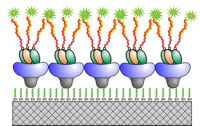
Center for NanoBiotechnology and University of Natural Resources and Applied Life Sciences, Gregor Mendel St. 33, A-1180 Wien, Austria
e-mail: Carina.Huber@boku.ac.at

 |
Carina Huber, Jing Liu, Eva M. Egelseer, Dieter Moll, Margit Sára, and Uwe B. Sleytr
Center for NanoBiotechnology and University of Natural Resources and Applied Life Sciences, Gregor Mendel St. 33, A-1180 Wien, Austria e-mail: Carina.Huber@boku.ac.at |
 |
A common feature of most bacteria and archaea is the presence of a regularly ordered, monomolecular surface layer (S-layer). These cell envelope layers are composed of identical species of protein or glycoprotein subunits which arrange themselves in a self-assembly process. Isolated S-layer subunits frequently maintain the ability to recrystallize into monomolecular protein lattices either in suspension or on solid supports (e.g. noble metals, silicon wafers, glass and plastic foils), as well as on lipid films and liposomes. The S-layer proteins SbsB of Geobacillus stearothermophilus PV72/p2 and SbpA of Bacillus sphaericus CCM 2177 are composed of a C-terminal self-assembly domain and an N-terminal SLH-(S-layer homology) domain which is able to specifically bind to a pyruvylated secondary cell wall polymer, the intrinsic anchor molecule of many S-layer proteins to the rigid cell wall layer.
To use S-layer proteins as building blocks for applications in nanobiotechnology, S-layer-streptavidin fusion proteins were constructed. These chimaeric heterotetramers were able to recrystallize on solid supports which optionally were precoated with secondary cell wall polymer. To characterize the S-layer supported affinity matrix, biotinylated oligonucleotides were bound and hybridization studies with complementary, fluorescently labelled oligonucleotides were performed. It could be demonstrated that S-layer-streptavidin heterotetramers represent novel tools for nanobiotechnology.